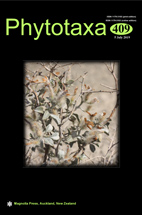Abstract
Two cloud forest species of Lycianthes are newly described: L. breedlovei from the state of Chiapas, Mexico and L. fredyclaudiae from the state of Baja Verapaz, Guatemala. Both species have orange-brown, multangulate-stellate trichomes in which the rays of the trichome are rebranched, white to pale lilac flowers (with darker violet-purple lobes in L. breedlovei), and unequal stamens. Morphologically, they resemble L. hortulana of Honduras, but both new species have previously been misidentified as L. cuchumatanensis. This article provides species descriptions, maps of geographic distributions, drawings of trichomes, and images of the flowers and specimens of the two new species, as well as a comparison chart of morphological characters used to separate L. breedlovei and L. fredyclaudiae from similar species.

